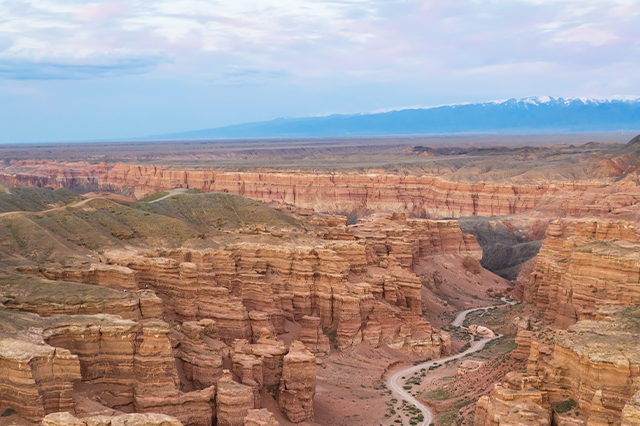Kazakhstan, a country with diverse and vast landscapes, is home to various wildlife, including the majestic steppe eagle. However, the fate of these legendary birds is under serious threat, primarily due to habitat destruction and the danger posed by modern infrastructure.
In this article, we look at efforts to conserve Kazakhstan's steppe eagle population. With the help of Jenny Weston, Senior Species Recovery Officer at the RSPB, we will look at the challenges, initiatives, and the crucial role of international cooperation in conserving these magnificent birds.
The Steppe Eagle, a raptor and symbol of Kazakhstan's rich cultural heritage, now stands at a crossroads; its future depends on the success of these conservation efforts.
1. Jenny, tell us how you became an expert on birds of prey conservation and what brought you to Kazakhstan.
I have worked on large raptors for nearly two decades, specifically red kites, eagles, and harriers, working for the Royal Society of the Protection of Birds (RSPB) and volunteering for the Scottish Raptor Study Groups. During this time, I have been part of reintroduction, field monitoring, and satellite tagging projects in the UK and abroad. I am also a member of the IUCN Vulture Specialist Group, having worked on the very successful Egyptian Vulture New LIFE Project and the Egyptian Vulture Flyway Action Plan and Vulture Multi-species Action Plan Reviews. Previously, I have presented at many conferences. Still, this visit to Kazakhstan is to attend the Eagles of the Palearctic Conference to learn more about eagle work in the region and exchange knowledge.
2. What are the main problems and challenges facing Central Asia and Kazakhstan steppe eagles?
Unfortunately, Steppe Eagle populations have declined by an estimated 48% across their range since 2000 and are globally endangered. As their name suggests, the Steppe Eagle inhabits grasslands, typically building nests on the ground. The intensification of agriculture across Europe and Central Asia has destroyed much of its habitat and depleted populations of prey species, such as ground squirrels and voles.
In Kazakhstan, the leading cause of the decline of steppe eagles is electrocution on uninsulated electricity pylons, a peril threatening many other large migratory birds.
Led by the Association for the Conservation of the Biodiversity of Kazakhstan (ACBK) and in partnership with the British Embassy and the RSPB, we hope to assess the impact of electrocution on steppe eagles by comprehensively surveying power lines in the new Bokey Orda State Protected Area in western Kazakhstan using purpose-built tools. Training will be provided to the Protected Area staff to ensure they are comfortable using these tools, and the data gathered will help identify power lines that need to be insulated to prevent more birds from dying.
3. What is the role of the British Embassy and the Royal Society for the Protection of Birds (RSPB) in this project? What motivated you to join forces?
The Embassy’s encouragement of strong Kazakh-British relations and generous funding has enabled the RSPB to continue working in partnership with ACBK, Kazakhstan’s most prominent national conservation organization. The RSPB has been working with ACBK to conserve birds and other important wildlife since 2005 when we produced the first inventory of Important Bird Areas across Kazakhstan. Our role is to provide ACBK with technical and financial support across various ecological restoration activities.
Our joint motivation to restore Steppe Eagle populations partly stems from their ecological importance. These eagles are an instrumental part of a healthy ecosystem as apex predators. The Steppe Eagle also holds cultural significance, featuring on the national flag of Kazakhstan and as a common motif in Kazakh art, including traditional textiles and embroidery. Kazakhstan is home to 60-85% of the world's breeding Steppe Eagles.
4. Can you tell us more about the Central Asian Flyway? Why is its conservation so crucial for the ecosystem of the region?
The Central Asian Flyway is an important migratory route that spans a vast area of Eurasia, stretching across 30 countries from the Arctic to the Indian Ocean. It connects the breeding grounds in Siberia to the wintering grounds in West and South Asia. It facilitates the seasonal journey of 182 migratory waterbird species, including 29 globally threatened and near-threatened species.
Conservation efforts focused on the flyway are essential for several reasons. Firstly, this migratory route is a natural bridge for various bird species as they travel thousands of miles, ensuring their survival by providing access to essential resources such as food, resting and roosting sites, breeding grounds, and freshwater to drink and bathe. Secondly, conserving the Central Asian Flyway supports the overall health of its ecosystems, including pollinating plants and dispersing seeds, which contribute to natural regeneration. Lastly, the flyway holds cultural and economic value for the communities along its path. Birdwatching tourism, for instance, thrives in areas where migratory birds make stopovers.
5. What contribution does the project expect to make to improving energy stability in rural areas of Kazakhstan? What is unique about your approach to this issue?
Bird-induced electrocutions impact society beyond conservation. Power outages disrupt enterprises, agencies, and rural communities, leading to substantial economic losses and increased use of expensive polluting generators. Swift, practical protection, and infrastructure modification implementation are imperative to safeguard steppe eagles and societal energy stability.
6. What impact is expected from the modernization of power transmission lines? Are there already examples of successful implementation of similar initiatives in other countries?
The electrocution of birds of prey and other birds is a threat across the globe, and several countries have successfully implemented insulation projects to improve the conservation status of their populations and increase energy security. For example, in Mongolia, there has been large-scale insulation of pylons nationwide, primarily to target Saker Falcon conservation. This has seen a 97% reduction in Saker Falcons killed on treated pylons. The Egyptian Vulture New LIFE project targeted critical areas along the flyway, surveying 2849km of power lines and insulating 1500 pylons. This reduced the number of carcasses found in follow-up surveys to zero.
7. Your participation in the international scientific and practical conference “Palearctic Eagles: Study and Conservation” implies exchanging experience and knowledge. What new ideas or techniques do you hope to bring back to the UK?
It was inspiring, as always, to hear from passionate conservationists working on eagles across the Palearctic. Particularly the projects that share data to produce more comprehensive analyses that can progress the conservation of a species. It was also fascinating to hear how threats to eagle species vary across their ranges, so targeting conservation actions is essential.
The RSPB plays a leading role in BirdLife International, a worldwide partnership of nature conservation organizations helping to deliver work such as the Kazakh Steppe conservation. Our learnings here could influence partner conservation efforts across the globe.
8. What place do international conservation agreements have in your work? How can Kazakhstan become an active participant in these agreements?
International conservation agreements play a central role in global conservation. They provide opportunities to share critical scientific findings with government staff and policymakers and subsequently influence national and international environmental commitments by providing clear goals to work towards. With colleagues at ACBK, we support the government of Kazakhstan in signing and meeting the requirements of international agreements. These include the CMS Raptor Memorandum of Understanding, an instrument of the Convention on Migratory Species, and convening signatories and cooperating partners to review the progress of raptor conservation activities and agree on future priorities.
9. What are your team's plans after completing this project? Is there a possibility of long-term cooperation with Kazakhstan in the field of nature conservation?
This project is designed to lead to the development of new projects that will conserve raptors and reduce power outages in rural areas across Kazakhstan. Results from training in the use of the newly created Survey123 App in both Kazakh and Russian will enable the growth of citizen science and professional research and monitoring within and beyond protected areas nationally. This will improve data gathering and the analysis that will inform conservation actions by Kazakh Government agencies, private sector companies, and investors in energy reform and development in the medium term. Both ACBK and RSPB have made long-term strategic commitments to understand better and thereby conserve the Steppe Eagle, both as a revered cultural icon and as a valuable indicator species of healthy steppe grasslands. Therefore, this initial project will be the first of a well-designed ongoing program of integrated future actions.
10. What would you recommend to the people of Kazakhstan and other Central Asian countries to preserve and protect their unique natural environment?
Kazakhstan has already made remarkable progress in safeguarding its biodiversity, as demonstrated by the extensive coverage of the State Protected Areas network, collaborative efforts with civil society organizations like ACBK, and the notable presence of important wildlife across the country’s steppe, semi-desert, mountain, and wetland ecosystems.
However, in the face of the escalating biodiversity and climate crises, it is essential for all nations, including Kazakhstan, to take even more substantial measures. The Kunming-Montreal Global Biodiversity Framework, adopted by Kazakhstan alongside more than 190 states in 2022, sets out 23 targets to prevent a further acceleration of species extinctions and more comprehensive biodiversity loss. These provide the best guidance for effectively conserving unique environments, including saving at least 30% of land and seas by 2030, reducing food waste and overconsumption, and involving Indigenous Peoples and local communities in environmental management and decision-making.
The struggle to conserve steppe eagles in Kazakhstan is not just a fight for a single species but is evidence of a wider struggle for biodiversity and ecological balance. The joint efforts of various organizations, including the Association for the Conservation of Biodiversity of Kazakhstan (ACBK), the Royal Society for the Protection of Birds (RSPB), and the British Embassy, highlight the importance of international cooperation in addressing global environmental issues. As this project comes to fruition, it will become a beacon of hope for steppe eagles and a model for conservation efforts worldwide. The story of the steppe eagle in Kazakhstan is a powerful reminder of our responsibility to nature and the interconnectedness of our global ecosystems.




















